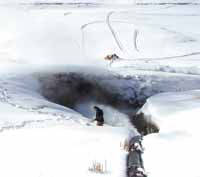| Winter water sampling at the discharge point of the James Canyon wells into Electric Lake. |
The Electric Lake water problem has been a major issue for PacifiCorp, since Aug. 16, 2001. The James Canyon well project has been instrumental in trying to replace water missing from Electric Lake.
At a recent meeting with the Emery County Water Users, Emery County Coal Operators, water rights and the Division of Oil, Gas and Mining, Dave Sharp, plant manager at the Huntington plant gave an update on the situation at Electric Lake.
Sharp began by giving some of the history of Electric Lake. Construction began on Electric Lake in 1970 and the gates were closed and the reservoir began filling on Nov. 27, 1973. In 1975 a major grouting project took place to prevent leakage where more than 1 million sacks of grout were used. The reservoir first filled to the spillway crest on June 6, 1980. The last time the reservoir was filled to the spillway crest occurred on June 9, 1999. The last time Electric Lake was as low as it is now was May 1975.
Sharp began a slide show presentation which showed the high water mark at the reservoir. In May of 2002 there was 10,641 acre feet of water. Sharp said they are in better shape this year than last year due to the continued pumping of the James Canyon wells. Sharp said they have had a lot of cooperation between the agencies, especially with the decision to reduce the flow of the Huntington Creek to 6 cubic feet per second in order to save water in the lake. Sharp said, “Without those two measures of reducing the flow out of the lake and the pumping of the water back into the lake, it would have been dry last fall.” Sharp described conditions with the James Canyon wells, one, two and three; they are on the same well pad and conditions are tight at the pad site.
Canyon Fuel-Skyline Mine initially drilled the James Canyon wells one and two and then PacifiCorp assumed operation of the wells and drilled another well, James Canyon three. These wells pose many difficulties including their 9,000 feet elevation which makes maintenance and water sampling difficult. Sharp said they struggled with JC-3 throughout last winter. They worked closely with the forest service and didn’t work on access roads to the wells during the elk calving season and other such environmental measures.
The drill bits for these large wells are 36 inches in diameter and involve a huge casing to encompass the bits. The well site was chosen for its proximity to the 10 left panel in the Skyline Mine. One of the conditions of the discharge permit for JC-3 is monthly sampling at the well site and the discharge point. Sharp said samples are taken on snowmobiles and they rented them the first year, but have since purchased a pair for use in the winter. He said because of the dangerous nature of the winter sampling that employees are never asked to do this job alone and are always sent into the well site in pairs. The site requires a lot of manual work to keep it operational.
JC-1’s capacity was approximately 2,000 gallons per minute and PacifiCorp worked with Skyline to upgrade the motor and the pump to increase its pumping capacity. JC-1 is located just outside of the mine area. PacifiCorp worked with Skyline Mine on an agreement to sink the JC-3 well directly into the mine and this was accomplished in late 2002. Capacity of JC-3 is 4,500-5,000 gallons per minute. Although the flow has been reduced to meet the requirements of the permits, JC-3 cannot go below 2,500 gallons per minute or the motor will lose its cooling capacities.
The limits of the discharge permit indicates that the discharge cannot be above 255 TDS, (total dissolved solids). Sharp indicated the water they are putting back into Electric Lake is good water, probably better than most municipal water systems around the country. Sharp said they have had some problems with the motor on JC-1 and there have been a number of debugging, start-up issues with JC-3 including a control transformer and a complicated installation process; but they are working through all these problems.
Sharp said there are a number of unresolved issues surrounding Electric Lake. There is not a technical solution to the problems at Electric Lake and nothing has actually been done to fix the lake, but a number of options are being explored. The number one goal is to keep the water in the lake and meet the obligations to the water users involved. The mine is finishing work in the area near the lake and the water will then be allowed to rise inside the mine workings, however, the impact to the lake is not known at this time. There has been some disagreement between the parties involved as to what caused the leakage initially.
Sharp said they carefully monitor all of the inflows and outflows into the lake and there is still water missing which cannot be accounted for. “It is a complicated issue and there isn’t a cheap solution but we are working and moving aggressively toward a long-term solution,” said Sharp, “If it was simple it would have been solved by now.”
The flows out of the mine, into the Price River drainage, range anywhere from 1,400 gpm to 4,000 gpm. The total flow coming into the mine continues to decline.

